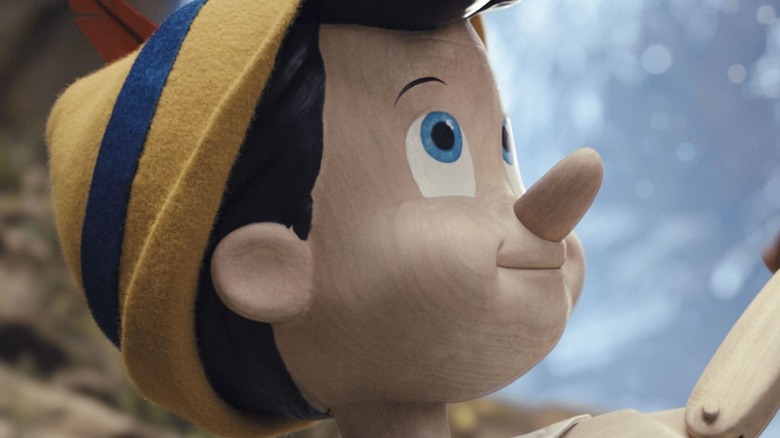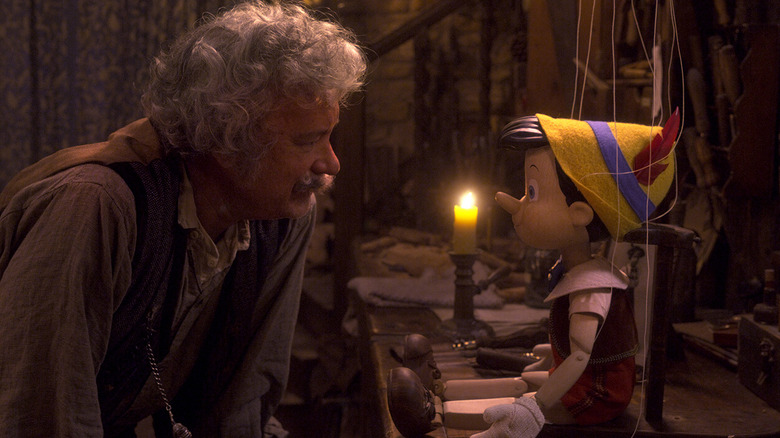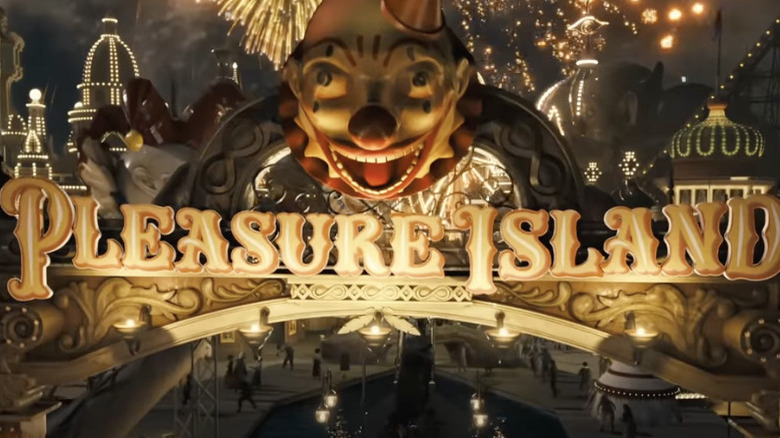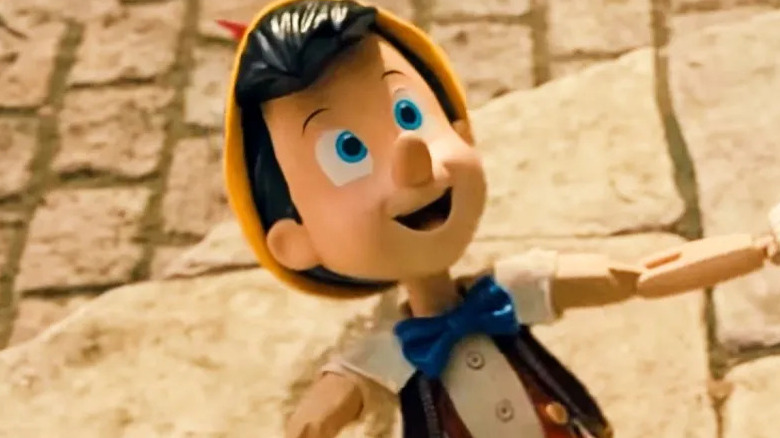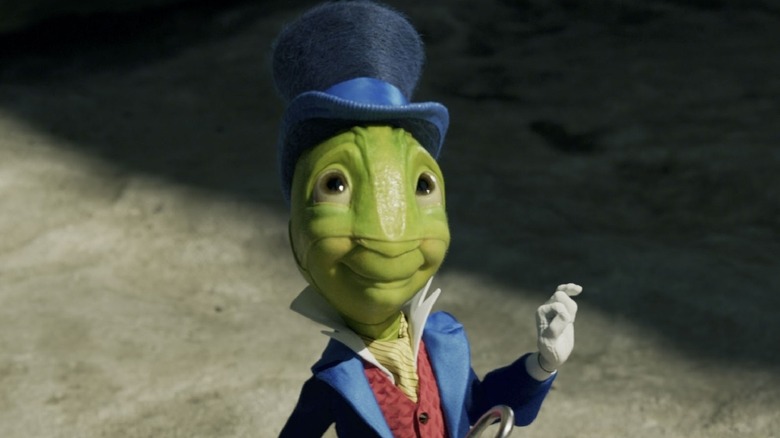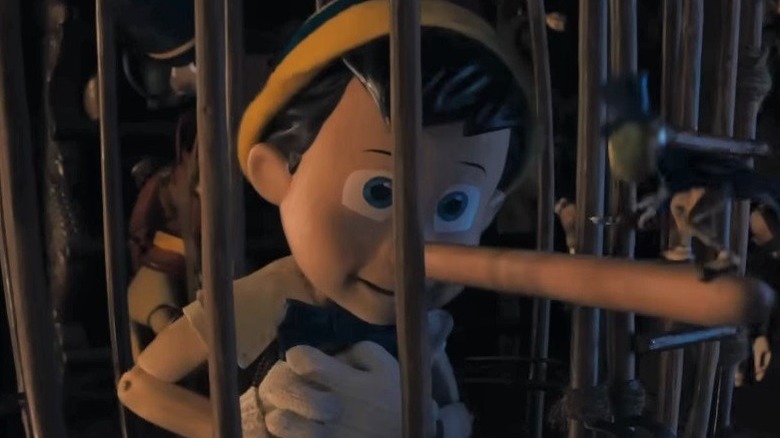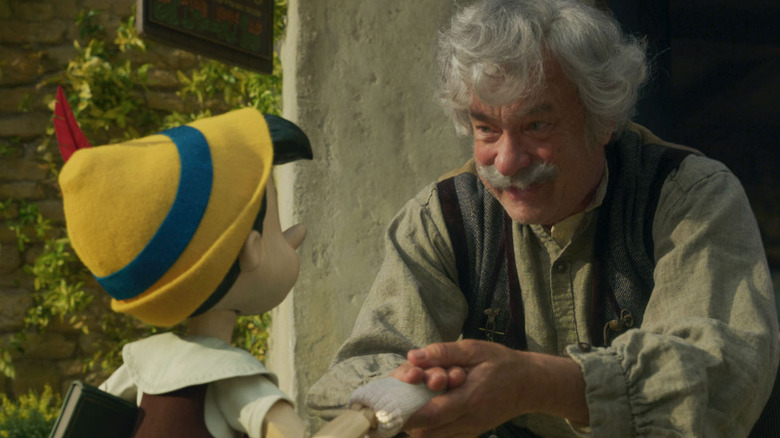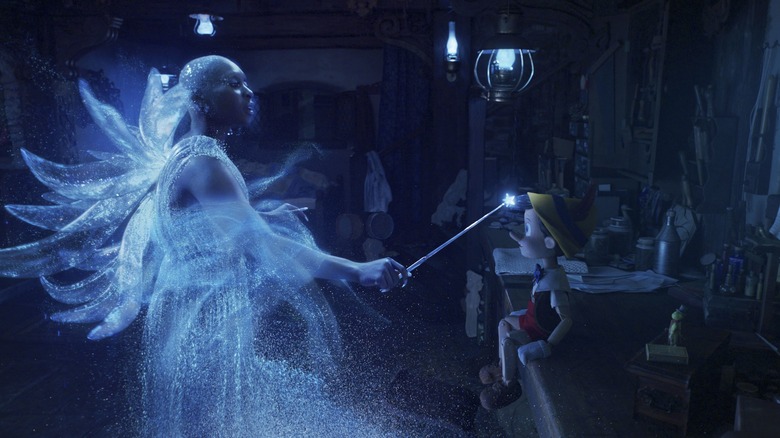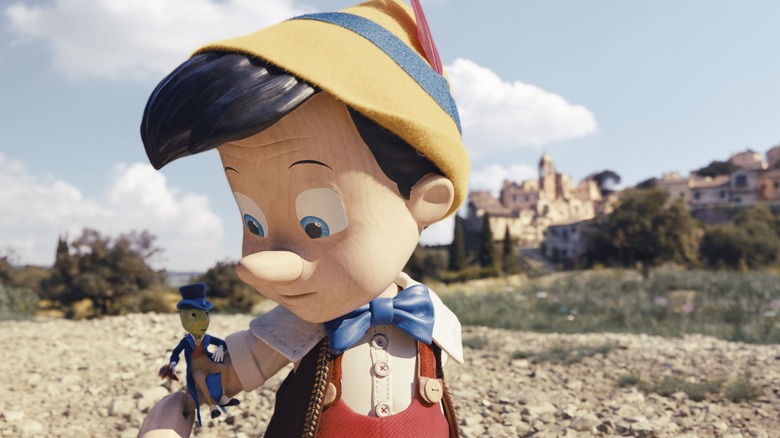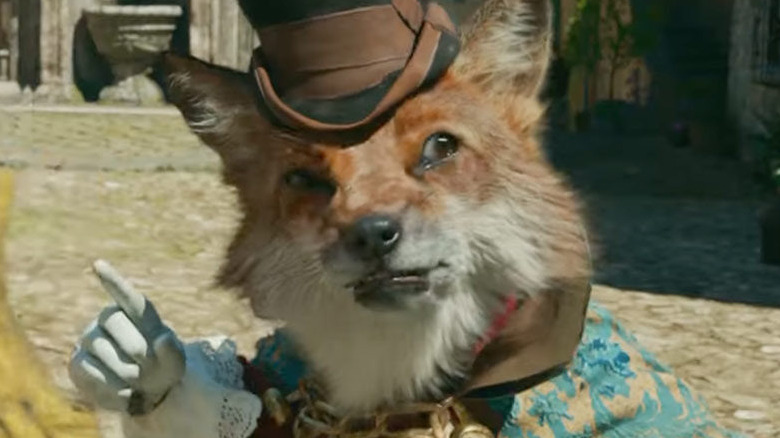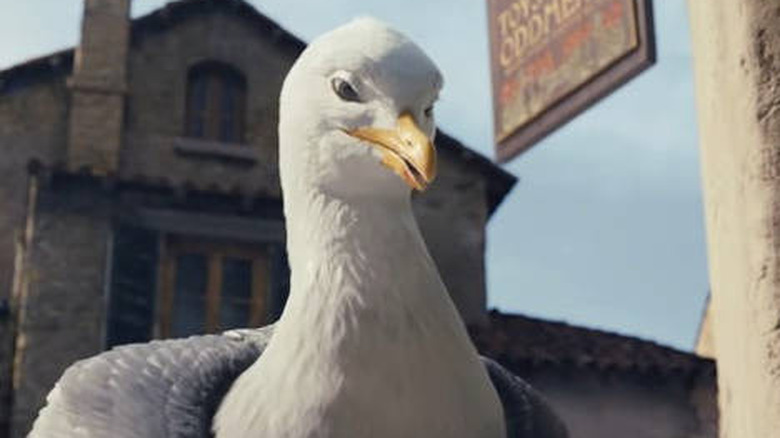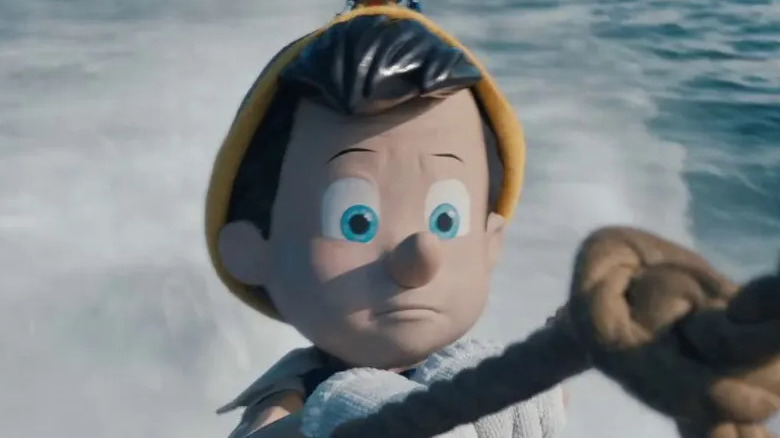Things Only Adults Noticed In Pinocchio (2022)
From its origins as an 19th century Italian novel through to its many adaptations for cinema and television, including Disney's monumentally popular 1940 animated version and the studio's 2022 live-action remake of that cartoon, "Pinocchio" is the alternately gentle and harrowing story of the titular character, a marionette-turned-human who endures a series of nightmarish trials to learn how the world works, and his personal moral code as he does, all of it a corollary for growing up. As much as "Pinocchio" is a story about children and for children, it's also for adults. All the action is set in motion by the desperate wish of Geppetto, an old man and wood carver who has lived a life of heartbreak and loneliness so severe that he makes a son for himself out of wood and paint.
This means that "Pinocchio" can be embedded with material and lessons that appeal to children as well as stuff just for adults. The 2022 Disney adaptation, starring Tom Hanks as Geppetto, is rife with jokes, lines, themes, references, and other bits that only grown-ups will catch and understand. Here are all the moments in the latest Disney "Pinocchio" made just for older viewers.
Geppetto isn't too successful in the love department
Not only do a couple of clever almost-but-not-quite swear words make it into the PG-rated 2022 Disney remake of "Pinocchio," but so does a very adult comment about human sexuality so subtle and meandering that only older viewers — and ones listening very closely to the dialogue, at that — would even notice, let alone understand it. Jiminy Cricket is the tool through which filmmakers address and answer a perpetual question about "Pinocchio": Why does Geppetto want a boy child so badly, and why does he think making a puppet kid out of wood and then aggressively, passionately wishing for it to turn into a real, living child is the fastest and most effective way to make that happen?
Jiminy Cricket explains it away with a joke, laded with shade and double entendre. "There are other ways to make a boy," Jiminy Cricket remarks when faced with the question. "But I don't think Geppetto gets out much so he did the best with the tools he's got." Ouch.
Pleasure Island is needlessly and expensively complicated
One of the most memorable (and frightening to younger viewers) moments in Disney's original 1940 animated production of "Pinocchio" was the Pleasure Island sequence, and the depiction of the consequences of a visit to the kiddie chaotic dream world of fun and misadventure. It necessarily had to be included in the 2022 live-action remake, and it's a true spectacle, a dazzling, fireworks-laden display of amusement park rides, petty crime, debauchery, and tomfoolery. Kids can eat all the junk they want, shoplift, break stuff, and cheat death, only to later learn that there's a price to be paid despite the free and enticing admission.
While the idea of "no such thing as a free lunch" or "every action has ramifications" are lessons far more familiar to adults than they are to children, older viewers may also find themselves at odds with the entire conceit of Pleasure Island. After engaging in the delights of the park, Pinocchio and his new friend Candlewick are transformed into donkeys. It's all part of a nefarious plan by the park's organizers. They lure in wayward youth and let them have all the fun they want, only for the park's dark magic to transform them into donkeys that can be sold off. The enormous expense, level of detail, and work required to create and maintain Pleasure Island doesn't seem to be worth the investment to turn kids into cheap pack animals.
Major philosophical questions are at play in Pinocchio
Most any film adaptation of "Pinocchio," including Disney's live-action 2022 version, is meant for an audience of children, as it's based on a 19th century children's book and it's about a child. "Pinocchio" also deals in some pretty heady concepts, ones that are far beyond most children and all but the most thoughtful and philosophically minded of adults. The "Pinocchio" story, and the 2022 take specifically and explicitly, is an exploration of ethics, what it means to be human, and if ethics are indeed what separates people from other animals or inanimate objects.
For all intents and purposes, Pinocchio is made a real-life boy just after Geppetto builds him, thanks to some magic from the Blue Fairy. However, while he's technically a human, Pinocchio is made to think that this status is provisional — that he won't really be real until he's lived a little bit, and learned how to be "brave, truthful, and unselfish." In other words, he has to prove his humanity and understand it before he can claim it. At the end of the film, Pinocchio is still made of wood, but he's learned those lessons and is thus declared an actual person.
Characters swear without swearing in Pinocchio
The 2022 Disney-produced live-action "Pinocchio" earned a PG rating, meaning that it's friendly to families and palatable to all but the youngest of children who might take issue with some of the more frightening and distressing moments of the film when Pinocchio or Geppetto find themselves in extreme danger. That PG rating is also a short way of saying "there are no bad words in this movie." This isn't to say, however, that the screenwriters weren't totally able to get around Disney's cleanliness mandate and a desire for a very mild MPAA rating. They inserted some bits that work as wordplay but which really subvert the PG rating to get in a couple of adults-only phrases.
Jiminy Cricket, the external and appointed conscience of Pinocchio is similarly the conscience of the audience, its surrogate in the crazy, fantasy world of the film. He openly questions the proceedings often, at one point rhetorically asking, "What the cuss is that all about?" Instead of saying a cuss word, he just says the word cuss as if it were a cuss word, an effective profanity-replacement lifted from Wes Anderson's PG-and-urbane "Fantastic Mr. Fox." Then, after Lampwick turns into a donkey but is not yet aware he's a donkey, he aggressively asks Pinocchio, "What do I look like, a jackass?" He means literally, in that a jackass is another name for a donkey, but it works on the other, metaphorical, slightly profane level, too.
There's a lot of child abuse in Pinocchio
Exactly who the protagonists and the antagonists, or quite literally the good people and the bad guys, are in the 2022 "Pinocchio" is made quite clear early and frequently. Older viewers will key in to the fact that all the good adults in the movie — clockmaker Geppetto, the Blue Fairy, and that's about it — exist to support, bolster, and champion Pinocchio. Geppetto loves Pinocchio the puppet so much he wills him into existence by way of the Blue Fairy, who gives the boy the moral imperative to prove himself worthy to call himself human. The bad guys, on the other hand, are not merely mean, crude, or dark — they're actively cruel, exploitative, and abusive.
The first individual that Pinocchio meets outside of Geppetto and the Blue Fairy, on his way to school, is the inaptly named Honest John, who heaps flattery and lies on Pinocchio so he can sell him to a performance troupe. Still, he makes it to school, where he lasts all of five seconds before he's kicked out — literally, forcefully and with shocking violence — by the schoolmaster, because school is for "real children." Winding up under the tutelage of puppet show master Stromboli, Pinocchio endures painful wrath once more, as the villain hurls him across a room and into a cage.
Geppetto gets over Pinocchio's origin rather quickly
Over a lifetime of consuming media, older viewers are conditioned to react emotionally to narratives. The 2022 version of "Pinocchio" spends its first third connected to Geppetto, sympathizing with and pitying the old and lonely man who just wants to know the joys of fatherhood and having something to love. Then viewers celebrate along with him when his marionette Pinocchio comes to life.
There's an abrupt disconnect then when almost immediately after fulfilling his ageless wish to be a dad, Geppetto seemingly washes his hands of it all. It's strange and confusing when after Pinocchio comes to life in the middle of the night and Geppetto celebrates his magical birth, he coldly tells him to go to school the very next morning. He gives him some school supplies, opens the door, and tells him the general direction where he needs to go, and what time he expects him home that afternoon. Geppetto shifts from warm to cold so fast that it's baffling. He doesn't even walk Pinocchio to school or let the teacher know that they'll have a new student. He could at least spend some time with his new son he (supposedly) so desperately wanted.
Everyone is way too hard on Pinocchio
In the 2022 "Pinocchio," the Blue Fairy (Cynthia Erivo) tells Pinocchio that while she has technically turned him human with magic, he's not really a human until he understands what it means to be human, by living life a little and adopting a code of ethics built around being "brave, truthful, and unselfish." That's all well and good, and those are good values to promote with a movie and instill in viewers, but older "Pinocchio" watchers might notice that Pinocchio isn't prepared to go out and learn these lessons, no thanks to the Blue Fairy or Geppetto.
Pinocchio is a blank slate. Before he sets off for school (and winds up going on a series of horrible and near deadly misadventures), Pinocchio has only been a living, conscious being for a few hours. He has no inner life, no frame of reference, no background, and no memories. He deals with the world as it comes to him, so he's bound to make a few mistakes. For example, he's overly trusting of shady strangers (like Honest John) and doesn't pick up on the cues that danger is around the corner (as with Pleasure Island). But then, he's chided, chastised, and punished for allowing himself to fall into so many moral and physical traps — ones he didn't even know existed. Pinocchio lets others take advantage of him, but he really wouldn't know any better to avoid that.
There's a lot going on with Jiminy Cricket
Older viewers, whether they like it or not, consume movies with a more critical eye than do younger ones, always analyzing things just a little bit — particularly when the entertainment is geared toward children and their brains might need slightly more engagement. It's from that point of view where it's made clear that Jiminy Cricket, in the 2022 live-action remake of "Pinocchio," is a complicated and dark figure with a potentially sketchy past.
Jiminy Cricket opens the film by singing the standard "When You Wish Upon a Star," made famous by the original "Pinocchio," with a knowing wink — as if to imply that he knows he and his song are known all over the world, or that the song even exists in this cinematic universe. He goes on to explain that he's in the contemporary age, telling the story of Pinocchio and Geppetto as if it happened in the distant past. Seeing as how "Pinocchio" takes place in the 1800s, this means Jiminy is well over 200 years old. He's lived a long life with many chapters, like how he's arriving in an Italian village for no reason at all, other than just that's where he's drifted. Soon, he's appointed Pinocchio's conscience, due to proximity more than any sort of moral authority. If anything, he's not the best ethical compass, because he might be kind of a weirdo; at the mention of Geppetto's selling of "oddments," he saucily quips, "Sounds like my kind of place."
The Pinocchio remake calls out the rich and powerful
Perhaps certifying Jiminy Cricket, in his position as Pinocchio's external advisor, as the boy's "conscience" is inaccurate or incomplete. While he doesn't ever provide much guidance or assistance other than vague worry (when he's even bothered to hang around, that is), he does offer platitudes about life in the form of sarcastic replies to the events of the movie as they unfold. Most of those gags serve a second purpose, as older, more seasoned viewers will observe, in offering social commentary on the cultural landscape of 2022, the year in which this version of "Pinocchio" was released. For a movie made by the powerful Disney, Jiminy Cricket's comments have an anti-Hollywood bent. After hearing Pinocchio excitedly tell him about Honest John, purportedly a talent agent who can make the kid famous, he says "Honest John? If someone calls themselves 'honest,' they're not. Especially if they're an agent."
That Honest John dishes out plenty of anti-corporate sentiment himself. He remarks that Pinocchio won't have to worry about much of anything when he's famous, particularly taxes, which feels like a politically-charged joke about certain elite figures. And then there's the whole overriding in-joke of the scene in which Honest John and Pinocchio meet: He only entertains the notion of being an actor because Jiminy Cricket — his conscience — isn't around to tell him it's a bad idea.
Some animals may speak, others may not
The nature of and ability of animals in 2022's "Pinocchio" remake just may puzzle older viewers, should they think too hard about it. The rules of the world in which the movie is set are inconsistent with regard to who can think and speak, and who cannot. There's obviously a supernatural element at play, as Pinocchio is transformed from wood to flesh through the actions of a human-size fairy, but there's no fantastical reason given for why some animals talk in the 19th century Italy of "Pinocchio" while others don't.
Jiminy Cricket is a bug, and he speaks, and is so trusted that he's tasked with serving as a conscience. Honest John is a fox the size of a small person, and he talks, but he's nasty and immortal. Sofia the seagull speaks (but only to other animals), while Geppetto's two pets, Figaro the cat and Cleo the goldfish, never pipe up. Maybe pets don't talk and wild, independent animals do? No, because Monstro the whale that swallows Geppetto, Pinocchio, and the pets never utter a word.
Pinocchio references many other movies
By and large, adults are more observant than younger folks, and those eagle-eye abilities come in handy, and are rewarded, when watching a big franchise-type movie, the kind that's bound to be replete with references to familiar pop culture of the past. The 2022 live-action remake of Disney's "Pinocchio" fits that mold, offering a number of Easter eggs to the viewers with the keenest and quickest perspectives.
An establishing shot of Geppetto's workshop lets the audience know that this version of the character is primarily a clockmaker — his wall is covered in dozens of clocks of the cuckoo, novelty, noisy, and mechanical varieties. While it's only noticeable for a few frames, many of those timepieces are Disney-branded items. Among the classic characters that make an appearance on Geppetto's clocks are Princess Aurora from "Sleeping Beauty," Donald Duck, some standouts from "The Lion King," and Roger and Jessica Rabbit from the Disney-adjacent "Who Framed Roger Rabbit" — the director of the latter happens to be Robert Zemeckis, who just so happened to have directed this very "Pinocchio" movie. He also co-wrote and helmed the 1985 sci-fi comedy "Back to the Future." This wall of clocks sure feels like a reference to Zemeckis's breakthrough and signature film — the time-travel-themed movie opened with a camera taking in a bunch of time-telling devices.
